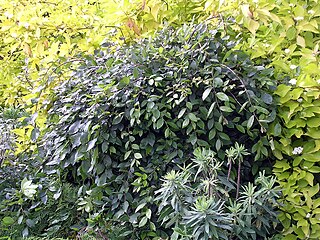Related Research Articles
The Chinese Elm cultivar Ulmus parvifolia 'Burgundy' was selected for its autumn foliage by Dr Michael Dirr and A. E. Richards from a tree on the University of Georgia campus, and first described in 1990.

Ulmus parvifolia 'Emer II' or 'Emerald Vase' is a Chinese Elm cultivar selected by Dr. Michael A. Dirr and cloned in the late 1980s from a tree planted circa 1910 on the University of Georgia campus at Athens, that had survived ice-storms undamaged. It was patented in 1991.
The Chinese Elm cultivar Ulmus parvifolia 'Emer I' or 'Emerald Isle' was cloned from a tree planted circa 1920 on the University of Georgia campus at Athens.

The Chinese Elm cultivar Ulmus parvifolia 'Drake' was marketed by the Monrovia Nursery of Azusa, California, first appearing in their 1952–1953 catalogue.
The Chinese Elm cultivar Ulmus parvifolia 'Dynasty' is a United States National Arboretum introduction resulting from a controlled crossing of two trees of Korean origin. First described in 1984, it is reputed to be very fast-growing.
The Chinese Elm cultivar Ulmus parvifolia 'Golden Rey' is an American clone selected by Oklahoma City nurseryman Bruce Rey in the late 1980s from a chance nursery seedling, and patented by him in 1990.
The Chinese Elm cultivar Ulmus parvifolia 'Hallelujah' is one of three American introductions made circa 1992 that were selected for their cold hardiness. 'Hallelujah' is known to have withstood -37 °C (-35 °F) in Missouri. The tree was first listed by the Arborvillage Nursery, Holt, Missouri, in its 1993–1994 catalogue.
The Chinese Elm cultivar Ulmus parvifolia 'Matthew' is one of three American introductions selected for their cold hardiness.
The Chinese Elm cultivar Ulmus parvifolia 'Milliken' is another American introduction.

The Chinese Elm cultivar Ulmus parvifolia 'Sempervirens' is an American introduction from south China, commonly known by the synonym 'Evergreen'. It was first listed by Bailey & Bailey in Hortus Second, 747, 1941.

The Chinese Elm cultivar Ulmus parvifolia 'Frosty', or 'Frosty' lacebark elm, was intended primarily as a dwarf variegated variety. Krüssmann (1976) states that it was raised in Japan. It was first distributed by the Mitsch Nursery, Oregon, USA.

The Chinese Elm cultivar Ulmus parvifolia 'King's Choice', patented in 1985, is one of the early American selections best known for its winter hardiness, being able to withstand temperatures of -30 degrees Celsius. It was originally selected for its "outstanding growth ".
The Chinese Elm cultivar Ulmus parvifolia 'Glory' is one of the early American selections, best known for its winter hardiness. It does not appear in Santamour and Bentz's 'Updated Checklist of Elm (Ulmus) Cultivars for use in North America' (1995).

The winged elm cultivar Ulmus alata 'Lace Parasol' was found by a North Carolina nurseryman growing in local woods. Removed to his yard, it remained there until his death, when it was removed again to the North Carolina State Arboretum in Raleigh by J. C. Raulston.

The Chinese Elm cultivar Ulmus parvifolia 'Pendens' was listed by Rehder in Journal of the Arnold Arboretum 26: 473, 1872 as Ulmus parvifolia f. pendens. The tree originated in California before 1930 from seed received from China.
The Chinese Elm cultivar Ulmus parvifolia 'Elsmo' was released by the USDA Soil Conservation Service, at Elsberry, Missouri, in 1990 as an open-pollinated, seed-propagated cultivar of extremely variable progeny.
The Chinese Elm cultivar Ulmus parvifolia 'Garden City Clone' was raised in Kansas. The champion tree was 18 m tall in 1993; however, the name 'Garden City Clone' is not officially recognized.

The Siberian elm cultivar Ulmus pumila 'Dwarf Weeper' was discovered in a western Illinois garden and sold by the Arborvillage Nursery Holt, Missouri.
Ulmus parvifolia 'BSNUPF' is a Chinese Elm cultivar, cloned from a chance seedling at Bold Spring Nursery, Bold Spring, Georgia. Patented in 2007, it was raised by John Barbour of Athena Trees, Monroe, Georgia.
The Chinese Elm cultivar Ulmus parvifolia 'Yarralumla' is a cultivar raised by the Yarralumla Nursery in Canberra, Australia.
References
- ↑ "Elm Leaf Beetle Survey". Archived from the original on 2011-07-19. Retrieved 17 July 2017.
- ↑ U. parvifolia 'Blizzard', J.C. Raulston Arboretum, jcra.ncsu.edu